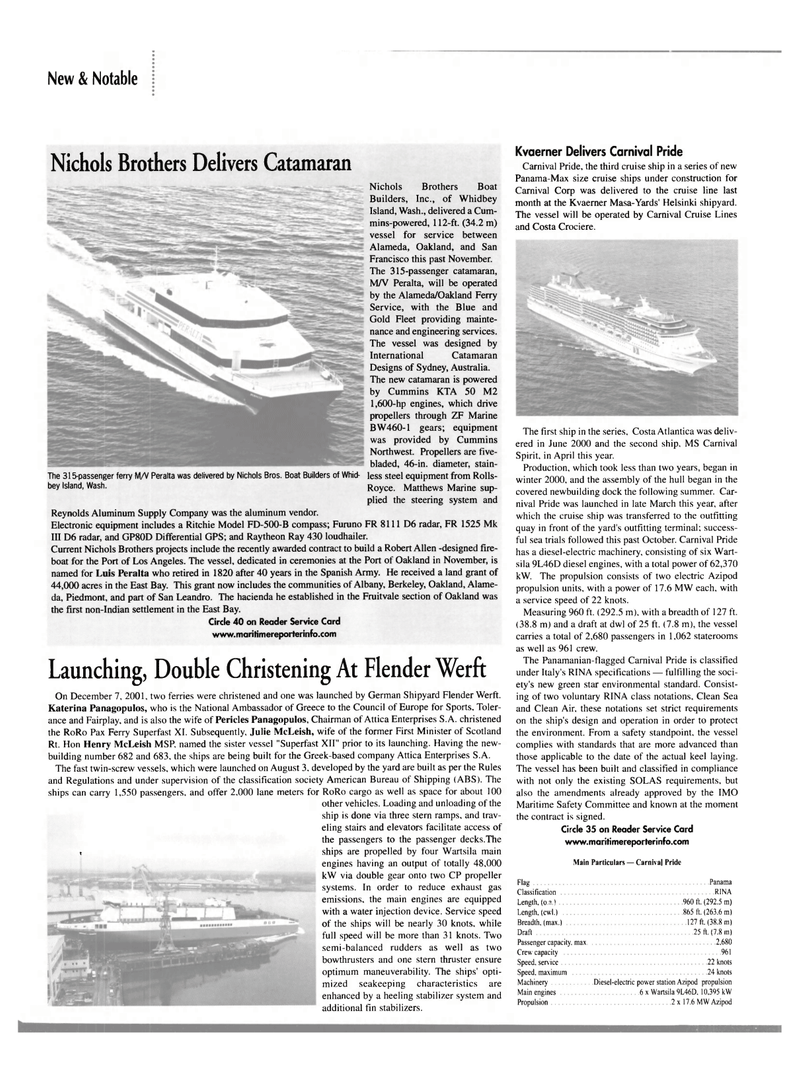
Page 15: of Maritime Reporter Magazine (January 2002)
Read this page in Pdf, Flash or Html5 edition of January 2002 Maritime Reporter Magazine
New & Notable
Nichols Brothers Delivers Catamaran
Nichols Brothers Boat
Builders, Inc., of Whidbey
Island, Wash., delivered a Cum- mins-powered, 112-ft. (34.2 m) vessel for service between
Alameda, Oakland, and San
Francisco this past November.
The 315-passenger catamaran,
M/V Peralta, will be operated by the Alameda/Oakland Ferry
Service, with the Blue and
Gold Fleet providing mainte- nance and engineering services.
The vessel was designed by
International Catamaran
Designs of Sydney, Australia.
The new catamaran is powered by Cummins KTA 50 M2 1,600-hp engines, which drive propellers through ZF Marine
BW460-1 gears; equipment was provided by Cummins
Northwest. Propellers are five- bladed, 46-in. diameter, stain-
The 315-passenger ferry M/V Peralta was delivered by Nichols Bros. Boat Builders of Whid- less steel equipment from Rolls- bey Island, Wash. Royce. Matthews Marine sup- plied the steering system and
Reynolds Aluminum Supply Company was the aluminum vendor.
Electronic equipment includes a Ritchie Model FD-500-B compass; Furuno FR 8111 D6 radar, FR 1525 Mk
III D6 radar, and GP80D Differential GPS; and Raytheon Ray 430 loudhailer.
Current Nichols Brothers projects include the recently awarded contract to build a Robert Allen -designed fire- boat for the Port of Los Angeles. The vessel, dedicated in ceremonies at the Port of Oakland in November, is named for Luis Peralta who retired in 1820 after 40 years in the Spanish Army. He received a land grant of 44,000 acres in the East Bay. This grant now includes the communities of Albany, Berkeley, Oakland, Alame- da, Piedmont, and part of San Leandro. The hacienda he established in the Fruitvale section of Oakland was the first non-Indian settlement in the East Bay.
Circle 40 on Reader Service Card www.maritimereporterinfo.com
Launching, Double Christening At Flender Werft
Kvaerner Delivers Carnival Pride
Carnival Pride, the third cruise ship in a series of new
Panama-Max size cruise ships under construction for
Carnival Corp was delivered to the cruise line last month at the Kvaerner Masa-Yards' Helsinki shipyard.
The vessel will be operated by Carnival Cruise Lines and Costa Crociere.
The first ship in the series, Costa Atlantica was deliv- ered in June 2000 and the second ship, MS Carnival
Spirit, in April this year.
Production, which took less than two years, began in winter 2000, and the assembly of the hull began in the covered newbuilding dock the following summer. Car- nival Pride was launched in late March this year, after which the cruise ship was transferred to the outfitting quay in front of the yard's outfitting terminal; success- ful sea trials followed this past October. Carnival Pride has a diesel-electric machinery, consisting of six Wart- sila 9L46D diesel engines, with a total power of 62,370 kW. The propulsion consists of two electric Azipod propulsion units, with a power of 17.6 MW each, with a service speed of 22 knots.
Measuring 960 ft. (292.5 m). with a breadth of 127 ft. (38.8 m) and a draft at dwl of 25 ft. (7.8 m), the vessel carries a total of 2,680 passengers in 1,062 staterooms as well as 961 crew.
The Panamanian-flagged Carnival Pride is classified under Italy's RINA specifications — fulfilling the soci- ety's new green star environmental standard. Consist- ing of two voluntary RINA class notations. Clean Sea and Clean Air. these notations set strict requirements on the ship's design and operation in order to protect the environment. From a safety standpoint, the vessel complies with standards that are more advanced than those applicable to the date of the actual keel laying.
The vessel has been built and classified in compliance with not only the existing SOLAS requirements, but also the amendments already approved by the IMO
Maritime Safety Committee and known at the moment the contract is signed.
Circle 35 on Reader Service Card www.maritimereporterinfo.com
Main Particulars — Carnival Pride
Flag Panama
Classification RINA
Length, (o.a.) 960 ft. (292.5 m)
Length, (cwl.) 865 ft. (263.6 m)
Breadth, (max.) 127 ft. (38.8 m)
Draft 25 ft. (7.8 m)
Passenger capacity, max 2.680
Crew capacity 961
Speed, service 22 knots
Speed, maximum 4 knots
Machinery Diesel-electric power station Azipod propulsion
Main engines 6 x Wartsila 9L46D, 10.395 kW
Propulsion 2 x 17.6 MW Azipod
On December 7, 2001, two ferries were christened and one was launched by German Shipyard Flender Werft.
Katerina Panagopulos, who is the National Ambassador of Greece to the Council of Europe for Sports. Toler- ance and Fairplay, and is also the wife of Pericles Panagopulos, Chairman of Attica Enterprises S.A. christened the RoRo Pax Ferry Superfast XI. Subsequently, Julie McLeish, wife of the former First Minister of Scotland
Rt. Hon Henry McLeish MSP, named the sister vessel "Superfast XII" prior to its launching. Having the new- building number 682 and 683, the ships are being built for the Greek-based company Attica Enterprises S.A.
The fast twin-screw vessels, which were launched on August 3. developed by the yard are built as per the Rules and Regulations and under supervision of the classification society American Bureau of Shipping (ABS). The ships can carry 1,550 passengers, and offer 2.000 lane meters for RoRo cargo as well as space for about 100 other vehicles. Loading and unloading of the ship is done via three stern ramps, and trav- eling stairs and elevators facilitate access of the passengers to the passenger decks.The j ships are propelled by four Wartsila main engines having an output of totally 48,000 kW via double gear onto two CP propeller systems. In order to reduce exhaust gas emissions, the main engines are equipped with a water injection device. Service speed of the ships will be nearly 30 knots, while full speed will be more than 31 knots. Two semi-balanced rudders as well as two bowthrusters and one stern thruster ensure optimum maneuverability. The ships' opti- mized seakeeping characteristics are enhanced by a heeling stabilizer system and additional tin stabilizers.

 14
14

 16
16
